The birth of a large litter of live pigs is the ultimate measure of success in the breeding herd. Total born litter size is between 14-16 pigs and has been increasing over the years. But increased litter size comes with greater risks for stillborns. If farms knew when sows would deliver, they could improve piglet survival by attending farrowings. Gestation length for the modern sow is 115-116 days but is normally distributed across 112-119 days.
Increased litter size is not related to length of gestation, but is associated with longer duration of farrowing, and increased risk for stillborns

Synchronized farrowing can help production flow, and improve labor efficiency. Farms can induce farrowing with prostaglandins the day before expected farrowing (114 d) in those that have not started farrowing by day 116, or prevent early farrowing on days 112-114, using oral progestogen. But it is currently not possible to know which sows will deliver early, on time, or even late.
In the weeks before farrowing, rapid fetal development causes a noticeable distention of the belly while the mammary glands also develop and swell.
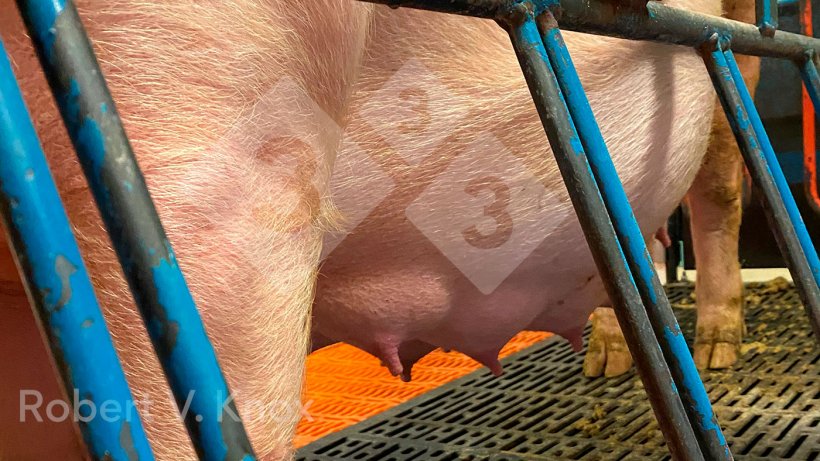
In the days before farrowing, small amounts of colostrum may drip from the nipple, and hours before delivery, milk can be stripped from the teat.

The sow may display a sway-back appearance, and the vulva may swell, redden, and relax.
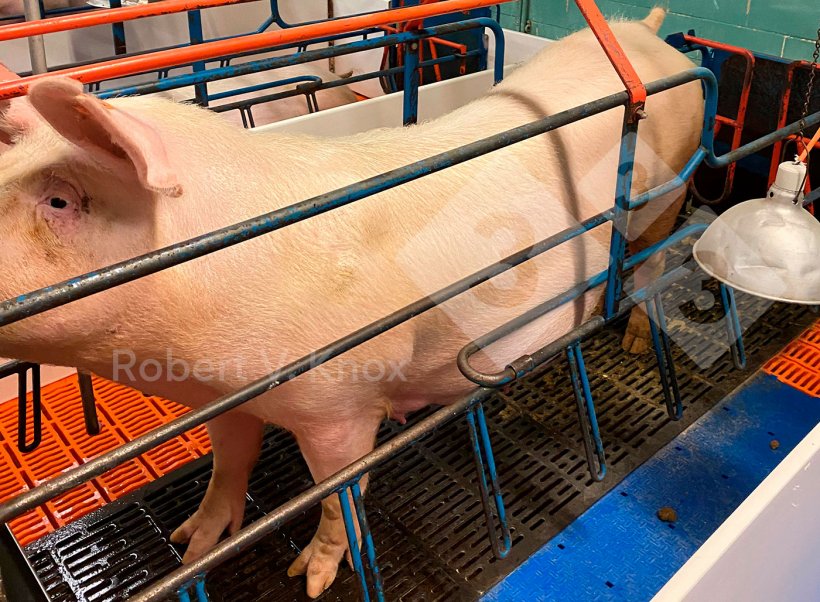
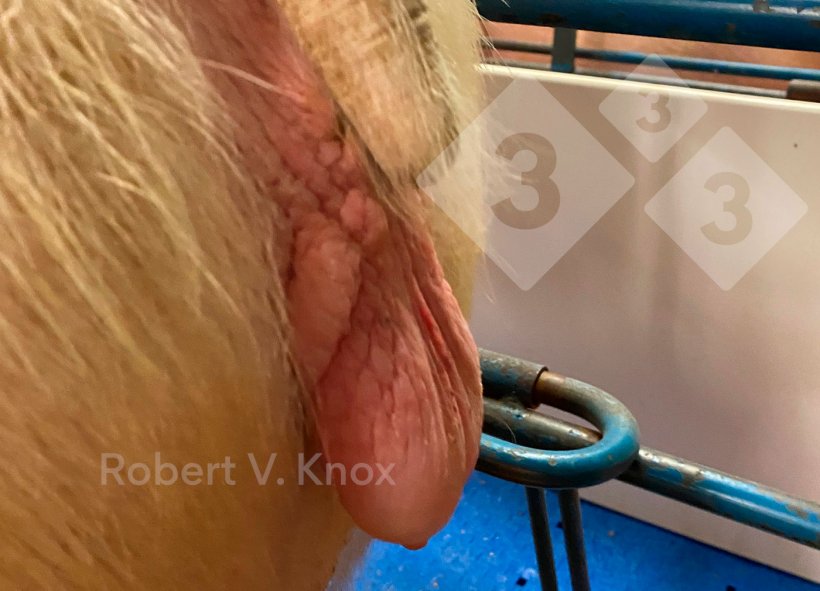
Within 12-24 h before farrowing, perhaps in response to oxytocin or prolactin, sows display nest building behavior, with pawing and nosing the floor, and biting the bars.
Before the first pig, the sow is restless and repeatedly gets up and lays down, before lying on her side for delivery.
As farrowing approaches, breathing rate will increase from ~20 to >60 breaths per minute.
Hormonal control of farrowing
While progesterone remains elevated until just before farrowing, placental estrogen increases in the weeks before. Other hormones, such as prostaglandin, relaxin, prolactin, and oxytocin increase in the days and hours before farrowing. Estrogen and relaxin combine to dilate the birth canal by weakening the connective tissues in the pelvis, cervix and vulva.
The signal to start farrowing originates with maturation of the piglet brains resulting in release of cortisol from the fetal adrenal. This causes an increase in placental estrogen and prostaglandin release by the uterus. High levels of progesterone supports uterine nourishment of the fetus while also limiting uterine contractions. The release of prostaglandin destroys the corpora lutea and progesterone is cleared within 12-24 h. Without progesterone, strong uterine contractions can be facilitated by prostaglandin and oxytocin to move the first pig and stretch the placenta into the cervix. With most of the placenta attached to the uterus, contractions cause the piglet’s feet to break the membranes and expel fluid.
Farrowing process
Once the fetus enters the cervix, a reflex induces the sow to push with her abdominal muscles (seen as she straightens her hind legs), to expel the piglet from the birth canal.
Farrowing is regulated so that one pig enters the birth canal at a time, while all others remain in place. Birth from the right or left uterine horn is random and pigs are born head or tail first without any link to survival during or after farrowing.
Contractions are controlled in frequency, strength, direction, duration, and the muscle layer activated. Neural signals from the reproductive tract of the mother regulate oxytocin and abdominal pushing, while local control from the placenta and uterus modulate hormones and receptors to stimulate or inhibit contractions. Contraction regulators include oxytocin, estrogen, progesterone, prostaglandins F2 and E2, and nitric oxide and calcium.
Each birth is associated with a peak of oxytocin, with piglets born at 15-20 minute intervals. But pigs can be born in quick succession or with extended intervals beyond 30 minutes. Piglets are often born with the umbilical cord still attached and with some of the amnion.

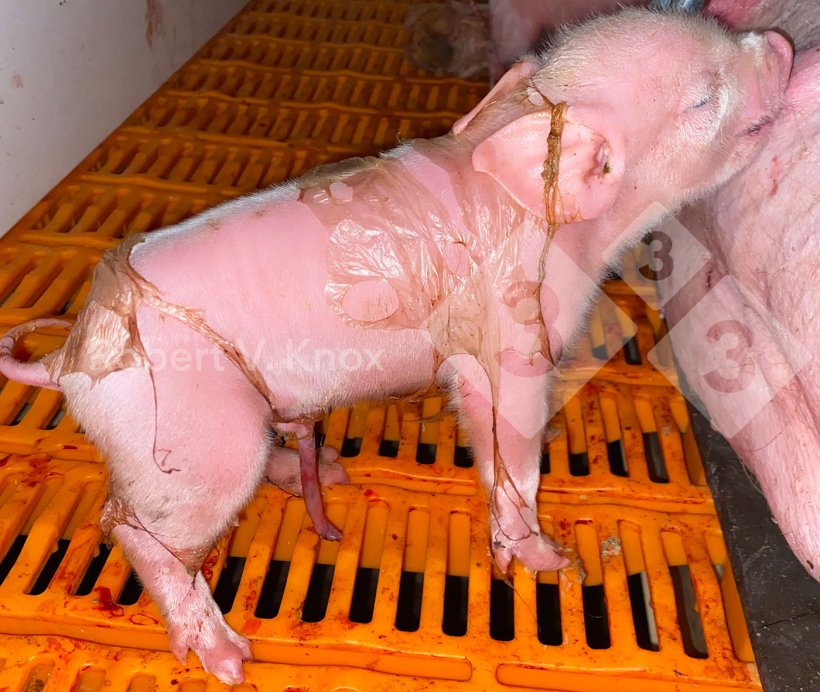
Within 5-15 minutes after birth, piglet movement ruptures the umbilical cord and allows the pig to locate the udder within ~20 minutes. Within in hours after the last pig, blood flow and pressure releases the placenta from the uterus and passage occurs.
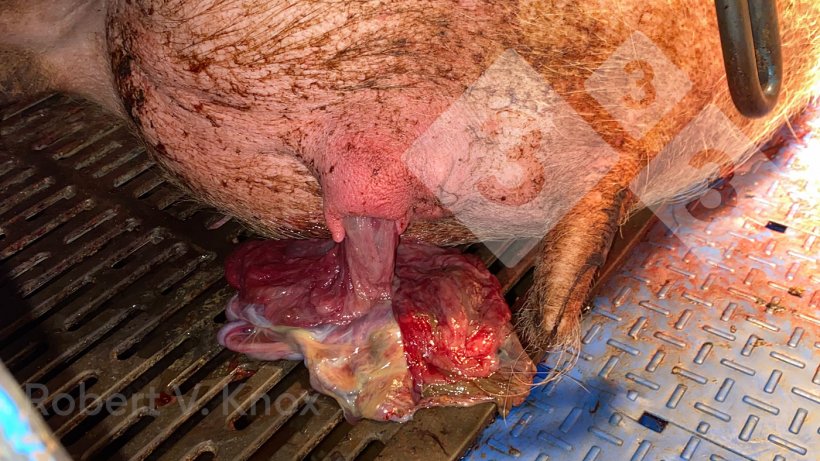
Stillborn
During farrowing, stillbirths are a great concern, since timely intervention can save 1 pig/sow/year. Stillborns occur more frequently in the last third of the litter, and in those with short (<113 days) and long (>117 days) gestation lengths. Stillbirths are linked to reduced contractions and sow fatigue, especially with longer duration of farrowing and with extended periods straining to push a pig through the birth canal.
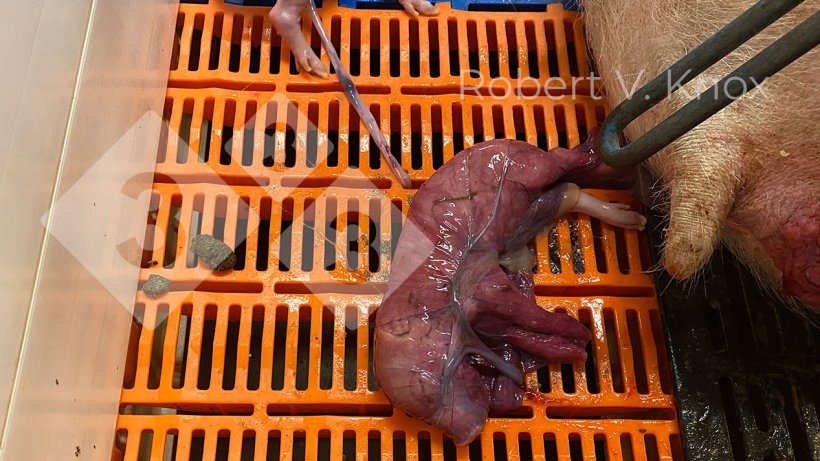
One indicator of a problem is when the interval from the last pig increases beyond 20 minutes and the sow appears to be straining. Pigs can die due to a lack of oxygen from a ruptured umbilical cord or due to limited blood flow during a sustained period of contractions. More than 50% of stillborn pigs have a ruptured umbilical cord and died of oxygen deprivation before or after entering the birth canal. For the last pigs in the litter, distance, time, and stretch on the umbilical cord could contribute to rupture. The half-life of oxygen is only 5 minutes, so timely intervention requires knowledge of birth intervals and observation of the sow.
Understanding the processes that control farrowing and recognizing the signs for the different stages of birth, can help farms develop effective management plans for the sow, facilities and labor to improve the likelihood for live born pigs.



